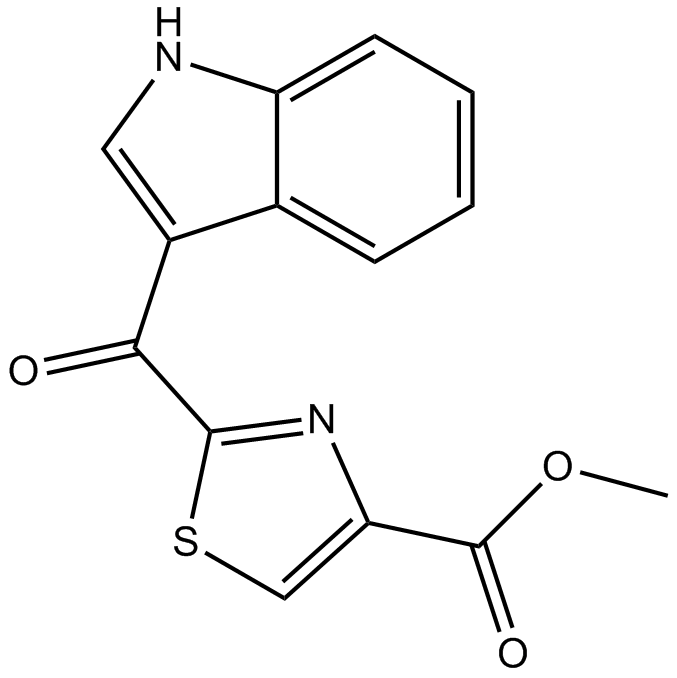ITE |
| Catalog No.GC12628 |
AHR agonist
Products are for research use only. Not for human use. We do not sell to patients.

Cas No.: 448906-42-1
Sample solution is provided at 25 µL, 10mM.
2-(1′H-indole-3′-carbonyl)-thiazole-4-carboxylic acid methyl ester (ITE) is a nontoxic immunosuppressive endogenous aryl hydrocarbon receptor (AhR) ligand [1] [2]. Its EC50 identified via yeast AhR assay is 7.8×10−10 mol/l [3].
AhR is a transcription factor mediating toxic effects of environmental pollutants such as 2, 3, 7, 8-tetrachlorodibenzo-p-dioxin (TCDD), it is activated by ligand [2].
ITE inhibited TGFβ1-induced myofibroblast differentiation in TGFβ1-challenged cultures of primary human fibroblasts from several distinct tissue types. In primary human orbital fibroblasts, ITE inhibited TGFβ1-induced nuclear translocation of Smad2/3/4 and its subsequent binding to SBE, but it did not inhibit TGFβ1-induced phosphorylation of Smad2/3, Erk1/2, or Akt [4], it inhibited TGFβ1 (1 ng/mL)-induced α-smooth muscle actin (α-SMA) expression, extracellular matrix production [5]. The inhibition of ITE to TGFβ1-induced myofibroblast differentiation in primary human fibroblasts is AhR independent [5].
In Sprague-Dawley rats maintained under a 12 h light/12 h dark cycle and given free access to a solid diet and distilled water, ITE at 1.6 and 8.0 mg/kg bw, significantly increased the CYP1A1 mRNA levels by 5.59 and 68.55 fold, respectively. It indicated that ITE activated AhR activation in placentas. 8.0 mg/kg bw ITE elevated the level of HIF-1a mRNA, induced the levels of VEGF-A, VEGF-B and PIGF mRNA in a dose-dependent manner [6].
References:
[1]. Lindsey F. Nugent, Guangpu Shi, Barbara P. Vistica, et al. ITE, A Novel Endogenous Nontoxic Aryl Hydrocarbon Receptor Ligand, Efficiently Suppresses EAU and T-Cell–Mediated Immunity. Invest Ophthalmol Vis Sci., 2013, 54(12):7463-7469.
[2]. Jaishree Bankoti, Ben Rase, Tom Simones, et al. Functional and phenotypic effects of AhR activation in inflammatory dendritic cells. Toxicol Appl Pharmacol., 2010, 246(1-2):18-28.
[3]. S. Medjakovic and A. Jungbauer. Red clover isoflavones biochanin A and formononetin are potent ligands of the human aryl hydrocarbon receptor. Journal of Steroid Biochemistry & Molecular Biology, 2008, 108:171-177.
[4]. Geniece M. Lehmann, Xia Xi, Ajit A. Kulkarni, et al. The Aryl Hydrocarbon Receptor Ligand ITE Inhibits TGFβ1-Induced Human Myofibroblast Differentiation. American Journal of Pathology, 2011, 178(4):1556–1567.
[5]. Geniece M. Lehmann, Xia Xi, Ajit A. Kulkarni, et al. The Aryl Hydrocarbon Receptor Ligand ITE Inhibits TGF1-Induced Human Myofibroblast Differentiation. The American Journal of Pathology, 2011, 178(4):1556-1567.
[6]. Yanming Wu, Xiao Chen, Qian Zhou, et al. ITE and TCDD Differentially Regulate the Vascular Remodeling of Rat Placenta via the Activation of AhR. PLoS ONE, 2014, 9(1): e86549.
Average Rating: 5 (Based on Reviews and 39 reference(s) in Google Scholar.)
GLPBIO products are for RESEARCH USE ONLY. Please make sure your review or question is research based.
Required fields are marked with *




















